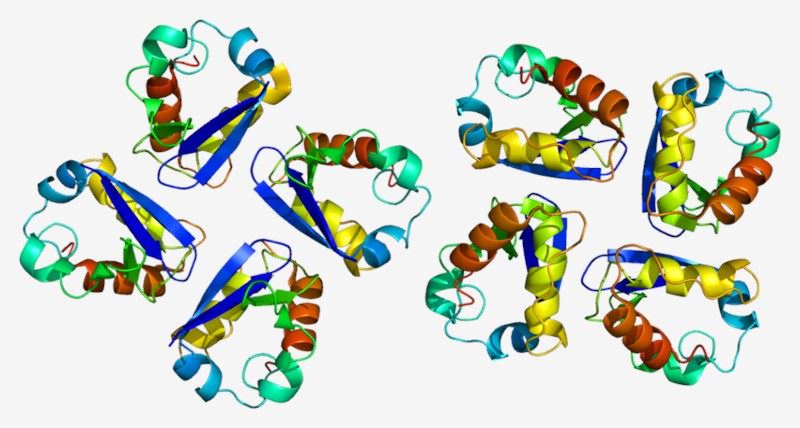Introduction of KCNA2
KCNA2, encoded by KCNA2 gene, is a member of potassium channel, voltage-gated, shaker-related subfamily which regulates the transportation of potassium ions across membrane in accordance with their electrochemical gradient. The channel consists of four subunits which interact with Kvβ subunit tetramer. Each subunit has 499 amino acids and contains 6 transmembrane segments (S1-S6) with a shaker-type repeat in S4 forming the voltage-sensor, and with the pore region between S5-S6 containing a selectivity filter and gating ion flow.
| Basic Information of KCNA2 | |
| Protein Name | Potassium voltage-gated channel subfamily A member 2 |
| Gene Name | KCNA2 |
| Aliases | HK4, MK2, HBK5, NGK1, RBK2, HUKIV, KV1.2, EIEE32 |
| Organism | Homo sapiens (Human) |
| UniProt ID | P16389 |
| Transmembrane Times | 6 |
| Length (aa) | 499 |
| Sequence | MTVATGDPADEAAALPGHPQDTYDPEADHECCERVVINISGLRFETQLKTLAQFPETLLGDPKKRMRYFDPLRNEYFFDRNRPSFDAILYYYQSGGRLRRPVNVPLDIFSEEIRFYELGEEAMEMFREDEGYIKEEERPLPENEFQRQVWLLFEYPESSGPARIIAIVSVMVILISIVSFCLETLPIFRDENEDMHGSGVTFHTYSNSTIGYQQSTSFTDPFFIVETLCIIWFSFEFLVRFFACPSKAGFFTNIMNIIDIVAIIPYFITLGTELAEKPEDAQQGQQAMSLAILRVIRLVRVFRIFKLSRHSKGLQILGQTLKASMRELGLLIFFLFIGVILFSSAVYFAEADERESQFPSIPDAFWWAVVSMTTVGYGDMVPTTIGGKIVGSLCAIAGVLTIALPVPVIVSNFNYFYHRETEGEEQAQYLQVTSCPKIPSSPDLKKSRSASTISKSDYMEIQEGVNNSNEDFREENLKTANCTLANTNYVNITKMLTDV |
Function of KCNA2 Membrane Protein
KCNA2 is widely expressed in the brain and the central nervous system where it participates in the regulation of neuronal action potentials, neuronal excitability, and neurotransmitter release. It has been revealed that homotetrameric KCNA2 functions as a delayed rectifier potassium channel which opens in response to membrane depolarization, subsequently via slow spontaneous channel closure. And the heteromultimer assembled by KCNA2 and KCNA4 displays rapid inactivation. The KCNA2 deficiency may lead to hyperexcitability and unnormal action potential. And the loss-of-function mutations in KCNA2 have been suggested to be associated with neuronal disorders such as ataxia, pharmacoresponsive epilepsy, and hereditary spastic paraplegia. Furthermore, the association between KCNA2 mutations and the clinical phenotype of epileptic encephalopathy is well known. KCNA2 mutations (1214 C > T, 889C > T, and 1195 G > A) have been identified to be associated with novel characteristics of epileptic encephalopathy including continuous polymyoclonus, electrical status epilepticus of sleep and status epilepticus. In addition, KCNA2 is also involved in the pathological process of congestive heart failure (CHF). The deficiency of Kcna2 lead to the reduced potassium current, action potentials prolongation, and the occurrence of ventricular arrhythmias.
 Fig.1 Structure of the KCNA2 protein.
Fig.1 Structure of the KCNA2 protein.
Application of KCNA2 Membrane Protein in Literature
The review summarizes the development of the field with regard to the gain-of-function potassium channel variants associated with epilepsy (KCNA2, KCNB1, KCND2, KCNH1, KCNH5, KCNJ10, KCNMA1, KCNQ2, KCNQ3, and KCNT1). This may provide new therapeutic strategies for epilepsy.
The study shows that the ventricular Kcna2 is upregulated in rats with congestive heart failure (CHF) and the deficiency of Kcna2 leads to the reduced potassium current, action potentials prolongation, and the occurrence of ventricular arrhythmias. This suggests that Kcna2 is a new therapeutic target for ventricular arrhythmias in patients with CHF.
The study shows that increased DNMT3a in dorsal horn leads to bone cancer pain through inhibiting dorsal horn Kv1.2 expression.
The study shows the strong genotype-phenotype associations between three subgroups of patients with KCNA2 encephalopathy according to the electrophysiological features of the mutations.
The study identifies the novel characteristics in 3 epileptic encephalopathy patients with KCNA2 mutations, including electrical status epilepticus of sleep, continuous polymyoclonus and status epilepticus.
KCNA2 Preparation Options
To obtain the soluble and functional target protein, the versatile Magic™ membrane protein production platform in Creative Biolabs enables many flexible options, from which you can always find a better match for your particular project. Aided by our versatile Magic™ anti-membrane protein antibody discovery platform, we also provide customized anti-KCNA2 antibody development services.
As a forward-looking research institute as well as a leading custom service provider in the field of membrane protein, Creative Biolabs has won good reputation among our worldwide customers for successfully accomplishing numerous challenging projects including generation of many functional membrane proteins. Please feel free to contact us for more information.
All listed services and products are For Research Use Only. Do Not use in any diagnostic or therapeutic applications.